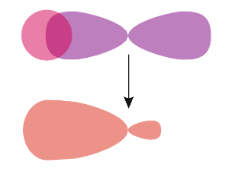
How many sigma and pi bonds are in the HCN molecule?
Answer
448.5k+ views
Hint: Hydrogen cyanide is an acid that has molecular formula
Complete step by step solution:
The strongest type of covalent chemical bond is a sigma (

The sigma (
Now, the covalent chemical bonds which are formed when the atomic orbitals overlap laterally are known as pi (

Pi (
Now, in HCN, we can see that there are two single bonds, H-C and C-N, hence it has two sigma (
So, the HCN molecule has 2 sigma (
Additional Information: Some of the properties of HCN are
- It can be synthesized by combining ammonia and methane
- It has an odor of bitter almond oil.
- It exists in both the gaseous as well as the liquid state.
- It has a melting point of 259.86 K and a boiling point of 299.00 K.
- It has a density of 0.69 g/l.
- It has a linear structure.
- It is extremely toxic as well as poisonous in nature and has been used as chemical weapons.
- It is colorless and is soluble and miscible in water and ethanol.
Note: It should be noted that even though pi (
Complete step by step solution:
The strongest type of covalent chemical bond is a sigma (

The sigma (
Now, the covalent chemical bonds which are formed when the atomic orbitals overlap laterally are known as pi (

Pi (
Now, in HCN, we can see that there are two single bonds, H-C and C-N, hence it has two sigma (
So, the HCN molecule has 2 sigma (
Additional Information: Some of the properties of HCN are
- It can be synthesized by combining ammonia and methane
- It has an odor of bitter almond oil.
- It exists in both the gaseous as well as the liquid state.
- It has a melting point of 259.86 K and a boiling point of 299.00 K.
- It has a density of 0.69 g/l.
- It has a linear structure.
- It is extremely toxic as well as poisonous in nature and has been used as chemical weapons.
- It is colorless and is soluble and miscible in water and ethanol.
Note: It should be noted that even though pi (
Recently Updated Pages
Master Class 11 Economics: Engaging Questions & Answers for Success

Master Class 11 Business Studies: Engaging Questions & Answers for Success

Master Class 11 Accountancy: Engaging Questions & Answers for Success

Master Class 11 English: Engaging Questions & Answers for Success

Master Class 11 Computer Science: Engaging Questions & Answers for Success

Master Class 11 Maths: Engaging Questions & Answers for Success

Trending doubts
Which one is a true fish A Jellyfish B Starfish C Dogfish class 11 biology CBSE

State and prove Bernoullis theorem class 11 physics CBSE

1 ton equals to A 100 kg B 1000 kg C 10 kg D 10000 class 11 physics CBSE

In which part of the body the blood is purified oxygenation class 11 biology CBSE

One Metric ton is equal to kg A 10000 B 1000 C 100 class 11 physics CBSE

Difference Between Prokaryotic Cells and Eukaryotic Cells




